| PlantID | 0103 |
| Botanical Name | Gymnema sylvestre |
| Common Name | Meshasringi |
| Classification | | Kingdom: | Plantae | | Subkingdom: | Tracheobionta | | Division: | Magnoliophyta | | Class: | Magnoliopsida | | Subclass: | Asteridae | | Order: | Gentianales | | Family: | Apocynaceae | | Genus: | Gymnema | | Species: | sylvestre |
|
| Part used | Whole plant, seeds, leaves and root. |
| Medicinal Properties | Whole plant: antiperiodic, diuretic and stomachic; seeds: emetic; leaves: hypoglycaemic; root: astringent, emetic, expectorant, refrigerant, stomachic and tonic.
|
| Medicinal Use | Whole plant: are used for the treatment of cold, ulcer, skin diseases, rheumatism, blood-vessel inflammation, hemorrhoids, and snake bites. Leaves: useful in cough, fever, and in the diabetes.
|
| Chemistry | Alanine, gamma-aminobutyric acid, isoleucine, valin, adenine, alkaloid, cyclic alcohol, inositol, d-quercitol, alpha- and beta-chlorophylls, lupeol, stigmasterol, gymnamosaponins, gymanamagenin, gymnestrogenin.
|
| Cultivation | NA |
| Regional Habitat | Found on Aravali hills. |
| Description | A large, stout, woody climber, with densely appressed hairy branchlets. Leaves: elliptic or obovate-acute, rarely pubescent above. Flowers: small, crowded umbelliform cymes. Fruits: slender, follicles, glabrous. Seeds: narrowly ovoid-oblong, flat with a broad thing wing, pale brown. Flowers during July-September and fruits during October-December.
|
| Image |  |


